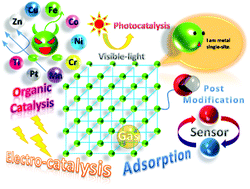Active metal single-sites based on metal–organic frameworks: construction and chemical prospects
Abstract
Metal single-sites are unique components that are indispensable in the composition of metal–organic frameworks (MOFs). Combined with the porous, crystalline, heterogeneous, and other characteristics of MOFs, the single-sites promote the rapid multidisciplinary development of the MOF platform. The multidimensional porous structure (2D,3D), abundant metal sites, and designable defect-engineering lay the foundation for researching the mechanism of metal unsaturated single-site systems. Suitable metal centers or open/unsaturated metal sites are conducive for optimizing the applications of MOFs in storage, separation, organic catalysis, degradation, contaminant removal, colorimetric sensing, and other related fields. In this review, we have first summarized the in situ emerged and post-modification synthetic methods of metal single-sites in the past five years, and have described the role of various sites in MOFs. Secondly, we have discussed the mechanism of action of the single sites and classified them based on the group ordinal number of the metal elements. Finally, we summarized the applications of MOFs with metal sites and propose potential development prospects. Last but not the least, we hope that this review will be helpful for quick access to valuable references about MOF single-sites and their applications.

- This article is part of the themed collections: 2021 Focus and Perspective articles and 2020 Focus and Perspective articles


 Please wait while we load your content...
Please wait while we load your content...